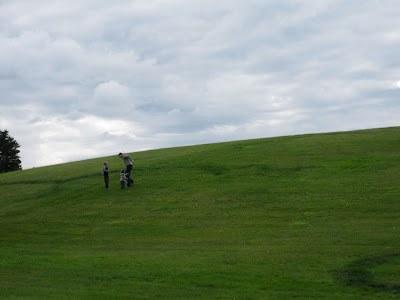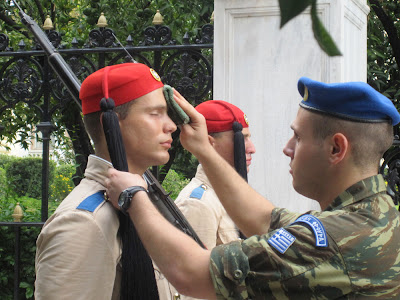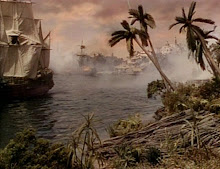<<Μακάρι να είχαν εκτελέσει και μένα μαζί με τον Νίκο>>
Της ΟΛΓΑΣ ΜΠΑΚΟΜΑΡΟΥ
Λευκά λαμπερά μαλλιά, μάτια σαν μικροί κρατήρες φωτός, κυρίαρχα σε ένα
πρόσωπο γαλήνης -αυτή είναι η πρώτη εικόνα που μου δίνει η Ελλη Παππά,
πηγαίνοντας να τη συναντήσω στο σπίτι της, στου Ζωγράφου, για τη
συνέντευξη που ακολουθεί. Με υποδέχεται ντυμένη απλά και κομψά - μια
χρυσή καρφίτσα στη βάση του λαιμού είναι το μοναδικό της στολίδι,
<<σημείο>>, σκέφτομαι, μιας χαμένης στις μέρες μας αρχοντιάς.
Σχεδόν μεσημέρι, ο ήλιος πέφτει απ' τις τζαμόπορτες στο διαμέρισμα,
5ος όροφος, ανοιχτός, όλο ταράτσες πολυκατοικιών, ο ορίζοντας. Μέσα,
βιβλία, πολλά βιβλία, δυο κυκλάμινα σε γλάστρες μπροστά στο σβηστό
τζάκι, το σκυλί της, η Βιόλα, να στριφογυρίζει, φωτογραφίες και
πίνακες -ανάμεσά τους, το γνωστό σκίτσο του Μπελογιάννη από τον Πικάσο
και το χειρόγραφό του που το συνόδευσε, σε άλλο κάδρο- ακίνητα.
Εχουν μόλις κυκλοφορήσει σε ανατύπωση, μέσα σε χάρτινη κασετίνα, τα
δέκα βιβλία μινιατούρες, παραμύθια που έγραψε ή διασκεύασε, ζωγράφισε
και βιβλιοδέτησε η ίδια, και τα 'στελνε στον μικρό γιο της -καρπό τής
σχέσης της με τον Νίκο Μπελογιάννη- όταν ήταν στη φυλακή και κείνος
μεγάλωνε στα χέρια της αδελφής της Διδώς Σωτηρίου. Την κοιτάζω, κάπου
μισόν αιώνα από τότε, το μικρό σώμα μέσα στη μεγάλη πολυθρόνα -ποιος
ξένος μπορεί να μετρήσει το βάρος εκείνου του συμβόλου, εκείνου του
μύθου πάνω της.
- Ησασταν στην ίδια φυλακή, της Καλλιθέας, όταν τον εκτέλεσαν. Πώς να
σας ρωτήσω τι αισθανόσασταν μέσα στην καρδιά αυτής της τραγωδίας;
Έλλη Παπα <<Δεν μπορείς να απαντήσεις, όσα χρόνια και αν περάσουν. Πώς να τα πεις
αυτά και πώς να τα νιώσουν οι άλλοι; Να είσαι εκεί και να τον πάρουν
απ' τα χέρια σου. Στη φυλακή, τον αποχαιρέτησα... Εμένα μου έδωσαν
χάρη, δηλαδή ισόβια, ως μητέρα που ήμουν, και δεν με εκτέλεσαν. Γιατί
κι εγώ είχα καταδικαστεί σε θάνατο>>.
- Πώς είναι να περιμένεις από ώρα σε ώρα έναν τέτοιο θάνατο;
<<Οταν είσαι εκεί, το ξέρεις, το έχεις αποδεχτεί, ότι κάποια στιγμή
μπορεί να συμβεί αυτό, να χτυπήσει η πόρτα και να σε πάρουν -πολλές
γυναίκες σκοτώθηκαν έτσι. Δεν μπορείς να κάνεις τίποτε άλλο* αν
κάνεις, θα προδώσεις... Το τραγικό για μένα είναι ότι δεν πήγα μαζί με
τον Νίκο. Διότι αυτό ήθελα. Να πεθάνω, να φύγω μαζί του>>.
- Παρ' ότι είχατε το παιδί;
<<Ναι. Το παιδί θα ζούσε, ίσως και καλύτερα χωρίς εμένα, και όταν
μεγάλωνε, θα καταλάβαινε... Οι γυναίκες στη φυλακή το αγαπούσαν απ'
την αρχή -όταν με σήκωσαν απ' του Αβέρωφ και με πήγαν στο μπουντρούμι
της Καλλιθέας για εκτέλεση, αυτές το έκρυψαν για μέρες όπου μπορούσαν:
από θάλαμο σε θάλαμο, κάτω από τα ράντζα των κρατουμένων, αρρώστησε
σοβαρά από το πήγαιν'-έλα, 6 μηνών παιδάκι ήταν, και το γιάτρεψαν.
Γιατί αυτοί, οι ασφαλίτες, με το πρόσχημα ότι θα το φέρουν σε μένα,
ζητούσουν να το πάρουν...>>
- Για ποιον λόγο;
<<Για άγνωστους λόγους. Τέλος πάντων, σώθηκε τότε κι όταν επέστρεψα
στις φυλακές Αβέρωφ, το ξαναβρήκα. Μείναμε μαζί ώσπου έγινε 3 χρόνων
-αυτό ήταν το όριο παραμονής παιδιών σε φυλακές- και πέρασε καλά,
γιατί όλοι τον αγαπούσαν και τον φρόντιζαν εκεί μέσα, και οι συγγενείς
απ' έξω ερχόντουσαν να τον δουν... Ο χωρισμός ήταν πολύ σκληρός και
για τους δυο μας* εμένα με έκανε κομμάτια. Ηταν φρίκη να βλέπεις το
παιδί σου μία φορά τον μήνα, για πολλά χρόνια. Ετσι έφτιαξα αυτά τα
βιβλιαράκια και μετά μια άλλη σειρά, με έργα του Αριστοφάνη... Ωσπου
αποφυλακίστηκα το '63, με το που βγήκε ο Παπανδρέου. Και ο Νίκος,
τελειώνοντας το Δημοτικό, έμπαινε στην εφηβεία...>>
- Και από τότε κύλησε η ζωή;
<<Ναι, αλλά δεν κύλησε έτσι δα. Γιατί είχαμε και τη χούντα το '67, και
πάλι χωρίσαμε με τον Νίκο... Πήγα εξορία. Στα Γιούρα. Οπου αρρώστησα
πολύ άσχημα και τότε οι Σοβιετικοί κατάφεραν να με πάρουν από κει, να
με φέρουν στην Αθήνα και τελικά να με ελευθερώσουν, χωρίς η ίδια να
γνωρίζω τίποτα. Με σκοπό να με πάρουν μαζί τους στη Σοβετική Ενωση,
για να ενισχύσουν τον αντιδικτατορικό αγώνα, στην ουσία για να με
αξιοποιήσουν υπέρ του καθεστώτος, προβάλλοντας την εικόνα του
κομμουνιστή που μένει πιστός στις ιδέες του. Είχαν κάνει μεγάλη
προετοιμασία, άρχισαν να στρώνουν το κόκκινο χαλί για να με δεχτούν,
αλλά δεν πήγα. Αρνήθηκα.
- Γιατί;
<<Γιατί είχε γίνει εν τω μεταξύ η εισβολή στην Τσεχοσλοβακία, προς την
οποία ήμουν αντίθετη. Ομως, ήταν πολύ βαρύ για κείνους αυτό που τους
έκανα. Και από τότε οι σχέσεις μας διαρρήχθηκαν. Δηλαδή με αγνόησαν,
και δικαίως. Πήγε στη θέση μου ο Ρίτσος για τον ίδιο σκοπό... Εγώ
έμεινα εδώ, προσπάθησα να σταθώ στα ποδια μου, ο Ευάγγελος
Τερζόπουλος, που ήμασταν μαζί στον 'Ριζοσπάστη', μου έδωσε δουλειά στη
'Γυναίκα'. Χωρίς να υπογράφω απ' την αρχή, γιατί ήταν χούντα ακόμα*
μου έλεγε για τις πιέσεις που δεχόταν, θα είχε πρόβλημα>>.
- Η πτώση του υπαρκτού σοσιαλισμού σας έκανε να σκεφτείτε ποτέ αν όλο
αυτό που έγινε, ο αγώνας και οι θυσίες τόσων ανθρώπων, άξιζε τον κόπο;
<<Αξιζε τον κόπο, αλλά καταρρακώθηκε από κάθε άποψη. Οταν το 1989
κατέρρευσε το σύμπαν, αποδείχτηκε ότι ήταν όλο εις μάτην. Οτι όλο αυτό
που λεγόταν Σοβιετική Ενωση γεννήθηκε για να πεθάνει>>.
- Ηταν αναμενόμενο για σας;
<<Εγώ και όσοι ήξερα δεν το είχαμε μετρήσει έτσι. Παρ' ότι από την
εποχή που ήμουν στη φυλακή, προ χούντας, έφταναν ώς εμάς από την
Σοβιετική Ενωση κάποιες πληροφορίες, σαν βαρίδια. Οπως π.χ. η
συνωμοσία κάποιων μεγαλογιατρών να φάνε διάφορα κομματικά στελέχη, που
τους έστειλαν στη Σιβηρία. Ηταν φοβερό* γιατί να γίνονται τέτοια
πράγματα εκεί, αναρωτιόμουν, είχα ταραχτεί τόσο, που φώναζα στον ύπνο
μου 'Σοβιετική Ενωση'! Τόσο δεμένη ήμουν μ' αυτό το κίνημα, τόσο
φοβόμουν, είχα το προαίσθημα ότι κάτι κακό θα συμβεί>>.
-Επαληθεύτηκε το προαίσθημά σας...
<<Ναι, από τότε όλα τα πράγματα άρχισαν να πηγαίνουν ανάποδα. Ωσπου
ήρθε ο Γκορμπατσόφ, που τον είδαμε σαν κάτι καινούργιο, ότι θα
μπορούσε να σώσει τον σοσιαλισμό. Αλλά μας την έδωσε την κατραπακιά,
αντί σωτηρίας είδαμε την οριστική κατάπτωσή του. Γιατί το σύστημα
κατέρρεε και ο Γκορμπατσόφ δεν μπορούσε ούτε καν να διαχειριστεί αυτή
την κατάρρευση>>.
- Τι το οδήγησε στην κατάρρευση αυτή;
<<Ηταν σάπιο απ' την αρχή αυτό που έστησαν και άκρως αντίθετο προς τις
ιδέες που ευαγγελιζόταν, οι οποίες βέβαια δεν έφταιγαν>>.
- Από την εποχή του Λένιν ξεκινάτε;
<<Να μην πούμε από τον Λένιν, αλλά από τον Στάλιν και πέρα άρχισε να
σαπίζει, βλέπαμε αυτή την πτώση. Ωσπου ήρθε, και ήταν τραγικό -η
Σοβιετική Ενωση εξαφανίστηκε, οι χώρες που τη συνιστούσαν είναι ξέφτια
πια... Από την ώρα που ένας Γιέλτσιν πήρε την εξουσία στη Ρωσία,
φάνηκε ότι το πράγμα δεν είχε πλέον ελπίδα. Διότι ήταν σάπιος και
αυτός, εξέφρασε όλη την παρακμή. Και είδατε πού καταλήξαμε: στον
Πούτιν>>.
- Το λέτε απαξιωτικά... Τι εκφράζει ο Πούτιν για σας;
- Τις μεγάλες μαφίες του πετρελαίου και του φυσικού αερίου. Ο,τι
εκφράζουν και αυτοί που έχουν φύγει από τη Ρωσία, ο Αμπράμοβιτς, ο
Χοντορκόφσκι κ.λπ. Αλλωστε, αυτές οι μαφίες, όλοι αυτοί, ξεπήδησαν
μέσα από την Κα Γκε Μπε, ουσιαστικά. Και ο Πούτιν ανάμεσά τους. Και
βλέπουμε σήμερα τις συνέπειες αυτής της κατάρρευσης να τις υφίσταται
όλος ο κόσμος. Και θα τις υφίσταται>>.
- Ποιες είναι συγκεκριμένα αυτές οι συνέπειες;
<<Οτι έχει τώρα τον Μπους και τους υπόλοιπους, που έχουν πέσει πάνω στη
γη να τη φάνε. Και κυνηγάνε τα πάντα, με πολέμους, με καταπάτηση των
ελευθεριών και των ανθρώπινων δικαιωμάτων, προκειμένου να το πετύχουν.
Με μοναδικό στόχο το χρήμα. Αυτό, το χρήμα, κυριεύει τον κόσμο τώρα,
αυτό διαφεντεύει τα πάντα. Αυτό είναι η εξουσία, όλες οι εξουσίες, το
μόνο πράγμα που έχει αξία* τίποτε άλλο>>.
- Δεν υπάρχουν διαφορές μεταξύ Πούτιν και Μπους;
<<Τι διαφορές; Απλώς, ο Μπους είναι ο χειρότερος εκφραστής αυτού του
γεγονότος, αυτού του εξαμβλώματος που έχει καταντήσει ο κόσμος...
Είναι φοβερό, μια επανάσταση, όπου είχαν επικεντρωθεί οι ελπίδες όλων,
να μεταλλαχθεί στο αντίθετό της. Και επιπλέον, να βιώνουμε όλη αυτή
την ξεδιαντροπιά, αυτό το έγκλημα της απώλειας των καλύτερων από τα
υλικά με τα οποία μπορεί να είναι φτιαγμένος ένας άνθρωπος>>.
- Επομένως, μπορεί να πει κανείς ότι τελικά οι ωραίες ιδέες δεν είναι
δυνατόν να βρουν εφαρμοργή στην κοινωνία των ανθρώπων;
<<Μπορεί να το πει>>.
- Αρα, ρίχνουμε αυλαία;
<<Οχι οριστική. Οι ιδέες για τις οποιες μιλούμε, τώρα δεν βρίσκουν
εφαρμογή. Ξανασυζητιούνται μετά από έναν αιώνα>>.
- Να έρθουμε λίγο και στα δικά μας, και να σας ρωτήσω πώς θα φτιάχνατε
το πορτρέτο του σύγχρονου Ελληνα.
<<Είμαι λίγο απ' έξω, όμως έτσι ίσως να βλέπω τα πράγματα πιο καθαρά.
Νομίζω, λοιπόν, ότι στον τόπο μας οι άνθρωποι ζουν πια χωρίς να ξέρουν
πού πάνε. Ποιο είναι το δικό τους συμφέρον, ποιος είναι ο εχθρός τους,
ποιος είναι ο σύντροφός τους, ποιος είναι ο φονιάς τους. Το μόνο που
τους ενδιαφέρει -και σ' αυτό συμβάλλει και η παιδεία, που είναι
ανύπαρκτη- είναι να ζήσουν σήμερα, τώρα>>.
- Να ζήσουν, με ποιον τρόπο;
<<Με ό,τι τους πλασάρουν τα περιοδικά λάιφ στάιλ και η τηλεόραση λάιφ
στάιλ. Που είναι ό,τι έρχεται απ' έξω, αλλά στο πιο κιτς>>.
- Υπάρχει κάτι όπου μπορούμε να προσβλέπουμε;
- Εγώ το μόνο, όπου προσβλέπω, όπου μπορώ να δω μια ελπίδα -τολμώ να
το πω- είναι η νέα γενιά. 'Βιάζεσαι', μου λένε μερικοί, αλλά το
πιστεύω, ακούγοντας τα ίδια τα νέα παιδιά που έρχονται εδώ, χωρίς να
τα ξέρω, για να μιλήσουν μαζί μου. Και διαπιστώνω ότι αρνούνται αυτόν
τον κόσμο, δεν τον θέλουν. Αυτό είναι το μόνο που με γαληνεύει στην
Ελλάδα σήμερα>>.
- Και η ελληνική Αριστερά; Πώς την επηρέασε αυτή η πτώση του υπαρκτού
σοσιαλισμού;
<<Ακόμα και η Ανανεωτική Αριστερά βρέθηκε να έχει χάσει πολλά από τα
πρότυπά της. Γιατί δεν είχε ποτέ, μεταπολιτευτικά, το θάρρος να
ξεκόψει απ' όλα αυτά και να εμφανίσει δικό της πρότυπο. Οσο για το
ΚΚΕ, έμεινε αναπολώντας περασμένα μεγαλεία>>.
- Για να καταλήξει πού η Αριστερά σήμερα;
<<Για την ώρα, δεν μοιάζει να καταλήγει πουθενά>>.
-Μερικοί υποστηρίζουν ότι δεν υπάρχει καν.
<<Εχει μια βάση αυτό. Είμαστε σε μια φάση επαναπροσδιορισμού των όρων
Αριστερά, αριστερός>>.
- Την πολιτική μας σκηνή, πώς τη βλέπετε συνολικά;
<<Σαν να είμαι στη θάλασσα και έχει τσούχτρες. Αυτό το γλοιώδες πράγμα
που σε τσιμπάει ξαφνικά και δεν ξέρεις από πού σου 'ρχεται>>.
- Τι θα λέγατε για τις δύο... κορυφαίες τσούχτρες του δικομματικού παιχνιδιού;
<<Είναι πολύ λίγοι και οι δύο για τις σημερινές ανάγκες του τόπου. Αλλά
δεν θέλω να μιλήσω για πρόσωπα. Θα σας πω μόνο ότι βλέπω μια
διολίσθηση προς το αντικοινωνικό κράτος τύπου Θάτσερ, όπου ο πολίτης
αντιμετωπίζεται ως όχληση προς τα μεγάλα συμφέροντα. Και η νομοθεσία
μεριμνά μόνο γι' αυτά>>.
- Για σας, θεωρούν ότι η σύνδεσή σας με τον Μπελογιάννη κυρίως, πέρα
από την δική σας μετέπειτα διαδρομή, σας προσδίδει το στοιχείο ενός
<<μύθου>> στον χώρο της Αριστεράς. Εχετε αυτή την αίσθηση;
<<Ποτέ δεν είχα τέτοια αίσθηση. Και όταν μου αποδίδουν άλλοι αυτόν το
χαρακτηρισμό, δεν ξέρω τι να τον κάνω>>.
- Λοιπόν, ποια θα λέγατε ότι είστε;
<<Δεν έχω καθήσει να το σκεφτώ ποτέ. Δεν είχα φανταστεί ότι θα είχα ν'
αντιμετωπίσω, κάποια στιγμή, τέτοια ερώτηση. Φοβάμαι και που την
ακούω>>.
- Ισως, κοιτάζοντας πίσω στη ζωή σας, πρόσωπο μιας τραγωδίας;
<<Δεν μπορώ να απαντήσω σ' αυτό. Το μόνο που ξέρω για τον εαυτό μου
είναι ότι είμαι μαχήτρια. Οπου και αν γυρίσω πίσω στη ζωή μου, δεν
βλέπω παρά τον άνθρωπο που μάχεται>>.
- Τι ήταν ο Μπελογιάννης στη ζωή σας;
<<Το άπαν>>.
- Αναρωτιέμαι αν, πενήντα τόσα χρόνια μετά, τον σκέφτεστε στην
καθημερινότητά σας...
<<Είναι πάντα κοντά μου. Τον αισθάνομαι. Τον ρωτάω για ό,τι κάνω. Και
εκείνος βρίσκει τον τρόπο να μου απαντήσει>>.
- Και αν μετράτε την οδύνη που σάς άφησε με ό,τι ωραίο σάς έδωσε αυτός
ο έρωτας.
<<Η οδύνη δεν μετράει. Είναι άλλο. Αισθάνομαι ως ευλογία τη συνάντηση
μαζί του. Ο πόνος τού πρόωρου χαμού του δεν είναι μόνο για μένα. Είναι
και για όσα θα μπορούσε να δώσει σ' αυτόν τον έρμο τόπο. Και δεν
πρόλαβε. Δεν τον άφησαν>>.
ΕΛΕΥΘΕΡΟΤΥΠΙΑ - 16/12/2006




















.jpg)




